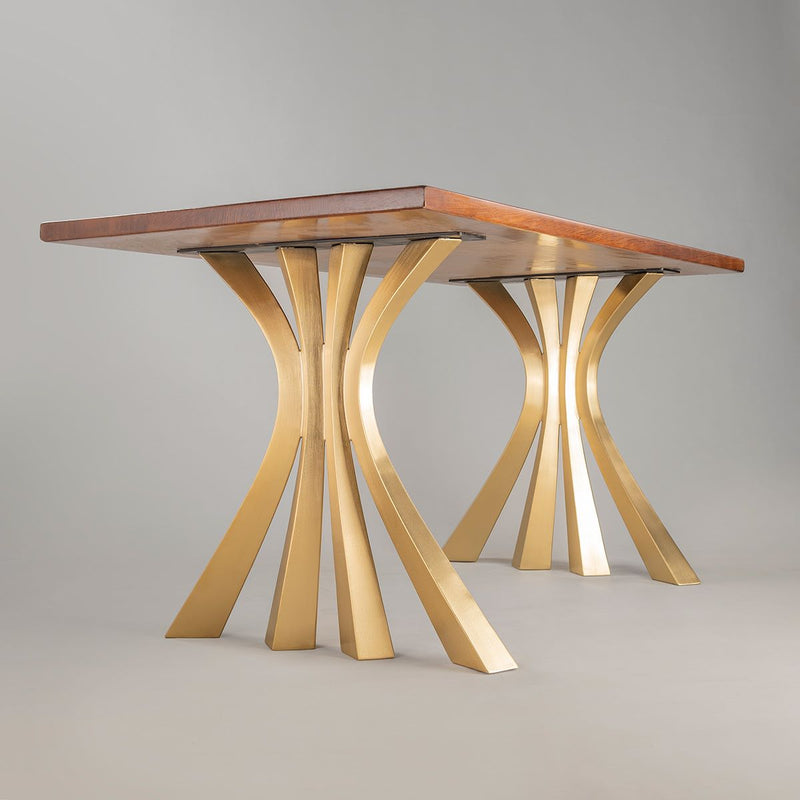A Thorough Take A Look At Table Leg Styles: Finding the Ideal Suit
Choosing the appropriate dining table leg design is essential for both visual appeal and functional functionality. For those with larger tables, trestle legs make sure sturdy assistance, whereas barrette legs introduce a mid-century contemporary ambiance with their minimal style. The x-shaped legs mix contemporary style with boosted security.
Standard 4 Legs
Among the various kinds of eating table leg styles, the typical four-leg layout continues to be an ageless option for numerous houses. 4 legs supply balanced support, ensuring the table continues to be secure and capable of bearing substantial weight (dining room table legs).
From a visual viewpoint, the conventional four-leg style can be conveniently adapted to various indoor designs. Whether crafted from timber, steel, or a combination of products, these legs can be delicately carved, streamlined and minimalistic, or anything in between. Their adaptability permits them to enhance both rustic and contemporary setups flawlessly.
Additionally, the straightforward structure of the four-leg style helps with ease of movement and positioning within a room. Unlike even more complex bases, this design lessens obstructions, offering adequate legroom for restaurants. In recap, the standard four-leg table leg design marries sustaining sophistication with practical capability, making it a sharp choice for those seeking both kind and function in their eating furniture.
Pedestal Base
Frequently celebrated for its sophisticated and space-efficient style, the pedestal base is a recognized option to the traditional four-leg configuration in dining table leg styles. Without edge legs, diners are afforded greater freedom of motion, making it a perfect selection for round and oval tables that advertise more intimate and comprehensive events.
Moreover, the stand base's main assistance can manage substantial weight, permitting for using larger tabletops, such as marble or thick wood. This toughness combined with its aesthetic flexibility makes the stand base a prominent choice in both conventional and modern interior settings. It can perfectly integrate with various layout themes, from classic elegance to minimal modernity. The main column itself uses a canvas for intricate styles and creative expressions, adding an element of aesthetic interest beneath the table. In summary, the stand base integrates performance snappy, making it a fine-tuned and functional alternative for varied dining atmospheres.
Trestle Legs
Trestle legs offer a durable and ageless structure for eating tables, identified by their straight cross-bracing and strong assistance beam of lights. Stemming from medieval times, this design has actually Click This Link advanced yet retained its vital structure, making it a seasonal fave in both typical and contemporary settings. The main trestle beam, frequently sustained by two or even more upright blog posts, uses why not try here extraordinary stability, permitting bigger table lengths without the demand for extra legs.
A substantial advantage of trestle leg tables is the ample legroom they use. Unlike tables with 4 corner legs, the lack of obstructions at the table's sides offers unblocked space for chairs and diners, boosting convenience and access. This makes trestle tables optimal for suiting larger gatherings, whether in a dining-room or a reception hall.
From rustic farmhouse to smooth modern-day layouts, trestle legs can be tailored to match private tastes. Their enduring charm and practical advantages make trestle legs an engaging option for those looking for both design and usefulness in their eating table.
Barrette Legs

The allure of hairpin legs depends on their simpleness and versatility - dining room table legs. Offered in a variety of materials, including steel and brass, they can be completed in countless shades to complement different interior styles. Whether coupled with a rustic wooden tabletop or a modern glass surface, hairpin legs effortlessly mix capability with a touch of vintage charm
Resilience is an additional notable feature of hairpin legs. In spite of their fragile look, these legs are crafted to bear considerable weight, making certain the eating table remains stable and protected. Furthermore, they are fairly easy to set up, making them a prominent option for do it yourself lovers and specialist furnishings makers alike.
X-Shaped Legs

Created from materials such as steel, timber, or a combination of both, X-shaped legs can be customized to match various style choices. Steel legs typically offer a sleek and industrial feel, ideal for loft-style apartment or condos and modern-day eating spaces. On the various other hand, wood X-shaped legs offer a warmer, a lot more rustic allure, pop over to this site suitable for farmhouse or eclectic insides. The versatility in materials enables homeowners to personalize their table to much better fit their overall design plan.
Additionally, the design behind X-shaped legs guarantees even weight distribution, decreasing the threat of tottering and boosting durability. This makes them particularly well-suited for bigger eating tables that call for added assistance. Fundamentally, X-shaped legs mix sensible design with modern looks, making them an ageless option for diverse dining environments.
Conclusion
An extensive understanding of dining table leg styles reveals the distinctive features and advantages of each design. Trestle legs make certain durable support for bigger tables, and barrette legs introduce a mid-century modern visual.